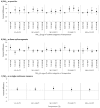Outdoor PM2.5, Ambient Air Temperature, and Asthma Symptoms in the Past 14 Days among Adults with Active Asthma
- PMID: 27385358
- PMCID: PMC5132644
- DOI: 10.1289/EHP92
Outdoor PM2.5, Ambient Air Temperature, and Asthma Symptoms in the Past 14 Days among Adults with Active Asthma
Abstract
Background: Relationships between air quality and health are well-described, but little information is available about the joint associations between particulate air pollution, ambient temperature, and respiratory morbidity.
Objectives: We evaluated associations between concentrations of particulate matter ≤ 2.5 μm in diameter (PM2.5) and exacerbation of existing asthma and modification of the associations by ambient air temperature.
Methods: Data from 50,356 adult respondents to the Asthma Call-back Survey from 2006-2010 were linked by interview date and county of residence to estimates of daily averages of PM2.5 and maximum air temperature. Associations between 14-day average PM2.5 and the presence of any asthma symptoms during the 14 days leading up to and including the interview date were evaluated using binomial regression. We explored variation by air temperature using similar models, stratified into quintiles of the 14-day average maximum temperature.
Results: Among adults with active asthma, 57.1% reported asthma symptoms within the past 14 days, and 14-day average PM2.5 ≥ 7.07 μg/m3 was associated with an estimated 4-5% higher asthma symptom prevalence. In the range of 4.00-7.06 μg/m3 of PM2.5, each 1-μg/m3 increase was associated with a 3.4% [95% confidence interval (CI): 1.1, 5.7] increase in symptom prevalence; across categories of temperature from 1.1 to 80.5°F, each 1-μg/m3 increase was associated with increased symptom prevalence (1.1-44.4°F: 7.9%; 44.5-58.6°F: 6.9%; 58.7-70.1°F: 2.9%; 70.2-80.5°F: 7.3%).
Conclusions: These results suggest that each unit increase in PM2.5 may be associated with an increase in the prevalence of asthma symptoms, even at levels as low as 4.00-7.06 μg/m3. Citation: Mirabelli MC, Vaidyanathan A, Flanders WD, Qin X, Garbe P. 2016. Outdoor PM2.5, ambient air temperature, and asthma symptoms in the past 14 days among adults with active asthma. Environ Health Perspect 124:1882-1890; http://dx.doi.org/10.1289/EHP92.
Conflict of interest statement
The findings and conclusions in this report are those of the authors and do not necessarily represent the official position of the CDC. The authors declare they have no actual or potential competing financial interests.
Figures


References
-
- Anderson SD, Daviskas E. The mechanism of exercise-induced asthma is... J Allergy Clin Immunol. 2000;106:453–459. - PubMed
-
- Andrade H, Alcoforado MJ, Oliveira S. Perception of temperature and wind by users of public outdoor spaces: relationships with weather parameters and personal characteristics. Int J Biometeorol. 2011;55:665–680. - PubMed
-
- Baur D, Saisana M, Schulze N. Modelling the effects of meteorological variables on ozone concentration—a quantile regression approach. Atmos Environ. 2004;38:4689–4699.
MeSH terms
Substances
LinkOut - more resources
Full Text Sources
Other Literature Sources
Medical
Miscellaneous

